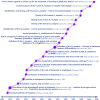Histamine pharmacology: from Sir Henry Dale to the 21st century
- PMID: 30341770
- PMCID: PMC7012941
- DOI: 10.1111/bph.14524
Histamine pharmacology: from Sir Henry Dale to the 21st century
Abstract
Histamine has been one of the most studied substances in medicine, playing a major role in diverse (patho)physiological processes. It elicits its multifaceted modulatory functions by activating four types of GPCRs, designated as H1-4 . Despite the heterogeneity and the complexity of histamine receptor pharmacology, many discoveries over the past 100 years resulted in the development of H1 antihistamines and H2 -targeting 'blockbuster' therapeutics for the management of allergies and gastrointestinal disorders respectively. Recently, a first-in-class H3 inverse agonist was approved for the treatment of narcolepsy, whereas H4 antagonists are under clinical evaluation for their potential therapeutic exploitation in immune-related diseases. This review critically presents the past successes and drawbacks in histamine research, complemented by the modern conceptual innovations in molecular and receptor pharmacology. It targets both young and experienced researchers in an ongoing effort to stimulate novel insights for the dissection of the translational potential of histamine pharmacology. LINKED ARTICLES: This article is part of a themed section on New Uses for 21st Century. To view the other articles in this section visit http://onlinelibrary.wiley.com/doi/10.1111/bph.v177.3/issuetoc.
© 2018 The British Pharmacological Society.
Conflict of interest statement
E.T. is currently president and M.E. is past president of the EHRS.
Figures



Similar articles
-
Histamine, histamine receptors, and neuropathic pain relief.Br J Pharmacol. 2020 Feb;177(3):580-599. doi: 10.1111/bph.14696. Epub 2019 Jun 7. Br J Pharmacol. 2020. PMID: 31046146 Free PMC article. Review.
-
Histamine in the kidneys: what is its role in renal pathophysiology?Br J Pharmacol. 2020 Feb;177(3):503-515. doi: 10.1111/bph.14619. Epub 2019 Apr 15. Br J Pharmacol. 2020. PMID: 30741418 Free PMC article. Review.
-
The role of the histamine H4 receptor in atopic dermatitis and psoriasis.Br J Pharmacol. 2020 Feb;177(3):490-502. doi: 10.1111/bph.14550. Epub 2019 Jan 2. Br J Pharmacol. 2020. PMID: 30460986 Free PMC article. Review.
-
Histamine receptors and cancer pharmacology: an update.Br J Pharmacol. 2020 Feb;177(3):516-538. doi: 10.1111/bph.14535. Epub 2018 Dec 13. Br J Pharmacol. 2020. PMID: 30414378 Free PMC article. Review.
-
Stimulation of histamine H4 receptors increases the production of IL-9 in Th9 polarized cells.Br J Pharmacol. 2020 Feb;177(3):614-622. doi: 10.1111/bph.14566. Epub 2019 Feb 21. Br J Pharmacol. 2020. PMID: 30589077 Free PMC article.
Cited by
-
The interplay between mast cells, pineal gland, and circadian rhythm: Links between histamine, melatonin, and inflammatory mediators.J Pineal Res. 2021 Mar;70(2):e12699. doi: 10.1111/jpi.12699. Epub 2020 Nov 29. J Pineal Res. 2021. PMID: 33020940 Free PMC article. Review.
-
Histamine H1 Receptor-Mediated JNK Phosphorylation Is Regulated by Gq Protein-Dependent but Arrestin-Independent Pathways.Int J Mol Sci. 2024 Mar 17;25(6):3395. doi: 10.3390/ijms25063395. Int J Mol Sci. 2024. PMID: 38542369 Free PMC article.
-
Structural basis for recognition of antihistamine drug by human histamine receptor.Nat Commun. 2022 Oct 15;13(1):6105. doi: 10.1038/s41467-022-33880-y. Nat Commun. 2022. PMID: 36243875 Free PMC article.
-
Histamine, Metabolic Remodelling and Angiogenesis: A Systems Level Approach.Biomolecules. 2021 Mar 11;11(3):415. doi: 10.3390/biom11030415. Biomolecules. 2021. PMID: 33799732 Free PMC article. Review.
-
Cryo-EM structure of cell-free synthesized human histamine 2 receptor/Gs complex in nanodisc environment.Nat Commun. 2024 Feb 28;15(1):1831. doi: 10.1038/s41467-024-46096-z. Nat Commun. 2024. PMID: 38418462 Free PMC article.
References
-
- Ackermann D (1910). Über den bakteriellen Abbau des Histidin. Hoppe‐Seylers. Z Physiol Chem 65: 504–510.
-
- Acosta‐Andrade C, Lambertos A, Urdiales JL, Sánchez‐Jiménez F, Peñafiel R, Fajardo I (2016). A novel role for antizyme inhibitor 2 as a regulator of serotonin and histamine biosynthesis and content in mouse mast cells. Amino Acids 48: 2411–2421. - PubMed
-
- Akdis CA, Simons FE (2006). Histamine receptors are hot in immunopharmacology. Eur J Pharmacol 533: 69–76. - PubMed
Publication types
MeSH terms
Substances
LinkOut - more resources
Full Text Sources
Miscellaneous

